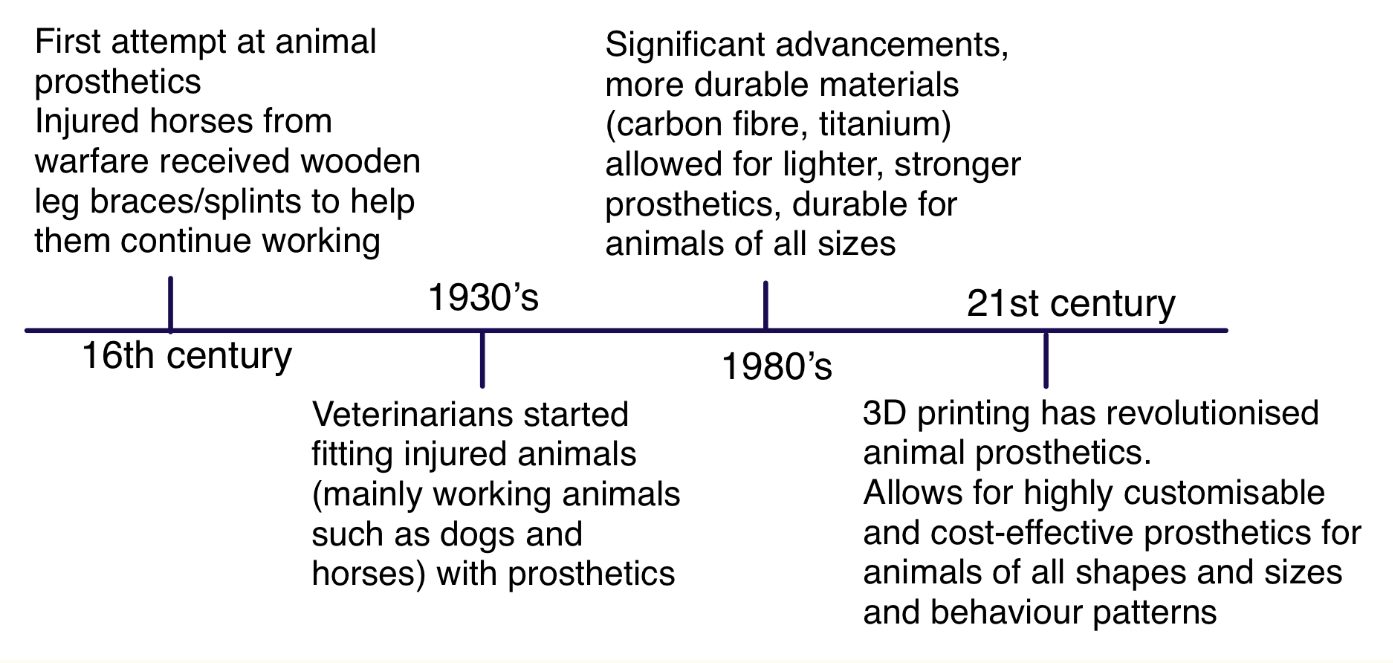Imagine a dragon regaining the ability to fly with a prosthetic tail. Now I’m not just talking about “Toothless” from the movie “How to train your dragon”, but this is a real emerging field in science where real animals in unfortunate situations get the chance to live a better life. As a pet owner myself, should something happen to my cats, I wouldn’t hesitate to provide them with the prostheses that they need to live comfortably again but is this really my choice to make? Are prosthetics for animals justifiable or are we just playing God?
Pivotal Events in Animal Prosthetics
Human prosthetics date back thousands of years but for animals, the idea emerged much more recently, evolving from rudimentary solutions to advanced personalised devices.

High Profile Cases
“Winter”, a bottlenose dolphin who lost her tail after getting caught in a fishing net received a 3D-printed tail. She slowly regained mobility and could swim again at the Clearwater Marine aquarium (they even made a movie about her! Watch “Dolphin Tale” for her full story).
Other notable cases:
Mr. Stubbs the Alligator
- First reptile to receive a prosthetic limb
- Lost his tail after being illegally transported
- Was fitted with a 3D-printed prosthetic one
Naki’o the Dog
- Rescued from a frozen puddle as a puppy
- Lost his paws and part of his tail due to frostbite
- Was fitted with 4 prosthetic limbs (first dog to have 4 prosthetic limbs!)
Motala the Elephant
- Lost her leg by stepping on a landmine
- Received a prosthetic leg
A Deep Dive into Ethics
All these cases are inspiring, however the question of whether we should be altering an animal’s body remains an ethical dilemma. While I believe for the most part that prosthetics can help improve an animal’s life, some ethical issues are raised:
- It’s not entirely clear if animals truly benefit from prosthetics long-term or if their suffering is simply prolonged.
- Often, the need for animal prosthetics may be driven more by the human desire to “fix” things rather than the animal’s genuine needs.
- In many cases, animals are given prosthetics for cosmetic reasons, to meet human expectations.
- Animals can’t voice their opinions, so the decision lies in the hands of veterinarians, caretakers and pet owners.
Legal Boundaries of Animal Prosthetics
While there are general veterinary medical guidelines ensuring the safety and well-being of animals undergoing procedures, legal frameworks related to prosthetics are still developing.
- There are no universal laws that protect animals from unnecessary prosthetic procedures.
- The cost of the prosthetics can be substantial.
- Insurance often doesn’t cover the procedures, as they are not always classified as medical necessities.
- Pet owners are left to bear the financial burden.
A New Era of Compassion
In the past century, society’s perception of disabled animals has drastically shifted. Injured/disabled animals were often euthanised, due to few chances of recovery. Now, thanks to animal advocacy groups, the public has become more sympathetic toward animals with disabilities, many seeing prosthetics as a viable way to provide their furry companions with fuller, happier lives. Rehabilitation has also proven that animals with prosthetics can not only survive but thrive in their environment.
Final Thoughts
Some scepticism still exists about whether animals truly need prosthetics, or if they are merely a human desire. Ultimately, I firmly believe that the decision to fit an animal with a prosthetic should be made in the best interests of the animal and should involve careful consideration of the animal’s needs and physical and emotional state by professionals.
References:
https://www.cmaquarium.org/animals/dolphins/winter
https://www.mentalfloss.com/article/55866/11-animals-amazing-prosthetics